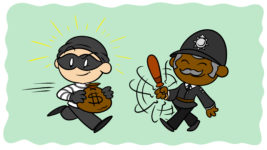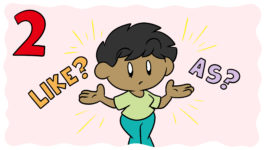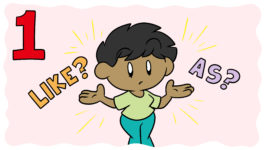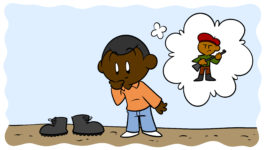Some writing advice is practical (cut your adverbs), some is theoretical (the structure of a story influences its message), and some is factual (the short-fiction market isn’t what it used to be). Personally, I’ve always found that the best writing advice deals with perception – the ability to understand how someone else will process your art. A hard fact of human nature can be revealed to you, and a new understanding of your goal as a writer seeps into every aspect of your process.
Today, we’re shooting for the moon with this type of perceptual advice, exploring a surprising fact about how some people process literature and how you can better serve them as your readers. And when I say ‘surprising’, I mean this one may really shock you. That’s why we’re beginning with…
A warning
The internet is full of hyperbole, so I’ll begin by saying that the observation underpinning this article may mean nothing to you. You may read it, shrug, and find it funny that there are people who are surprised.
On the other hand, this article may tell you something that directly applies to how you perceive the world. It may, in fact, be something that takes you days or weeks to process. Don’t get me wrong, you’ll be glad you know, but if you’re currently deciding whether to read this article on the bus to work or wait until you’re home this evening with a cup of cocoa, it might be worth waiting for the latter.
So, that’s the warning, and while it may be unnecessary, I promise it’s sincere. Once you’re ready, let’s talk about aphantasia.
What is aphantasia?
Let’s begin with a revelation. Or, I suppose, two revelations. The drag is that only one of them can surprise you. As mentioned, you may be the sort of person who already knows both, but if not, you’re in for a real shock. Ready?
Revelation 1: Some people can picture things in their mind.
Revelation 2: Some people can’t picture things in their mind.
If you’re the type of person who doesn’t find either of these points surprising, it’s safe to roll your eyes now, but if you’re the type of person who didn’t already know the above, you probably need some more context.
Many people report the ability to literally picture images using their imaginations – they can, for all intents and purposes, ‘see’ a picture in their mind. Other people – and these appear to be in the minority – have absolutely no visual imagination. I’ll let Blake Ross explain it from the perspective of the second group:
I have never visualized anything in my entire life. I can’t “see” my father’s face or a bouncing blue ball, my childhood bedroom or the run I went on 10 minutes ago. I thought “counting sheep” was a metaphor. I’m 30 years old, and I never knew a human could do any of this. And it is blowing my goddamn mind.
If you tell me to imagine a beach, I ruminate on the “concept” of a beach. I know there’s sand. I know there’s water. I know there’s a sun, maybe a lifeguard. I know facts about beaches. I know a beach when I see it, and I can do verbal gymnastics with the word itself.
But I cannot flash to beaches I’ve visited. I have no visual, audio, emotional, or otherwise sensory experience. I have no capacity to create any kind of mental image of a beach, whether I close my eyes or open them, whether I’m reading the word in a book or concentrating on the idea for hours at a time – or whether I’m standing on the beach itself.
And I grew up in Miami.
This is how it’s always been for me, and this is how I thought it was for you.
– Blake Ross, ‘Imagine a dog. Got it? I don’t. Here’s what it’s like to be unable to visualize anything’, Vox
This trait – the inability to visualize things in your head – is commonly known as ‘aphantasia’. While it’s an area still under study, current findings suggest visual imagination exists on a spectrum – some people can overlay the real world with intricate, moving pictures, some can picture still images, some can picture ‘shadowy’ half-images, and some people (perhaps around 2%) see nothing.
Some important facts to cover: aphantasia isn’t a disease, it’s just a trait, and it doesn’t exclude anyone from creating or enjoying art (though it does influence how they create or enjoy art).
[Professor Adam Zeman] doesn’t think aphantasia needs diagnosis and treatment. “It’s an intriguing variation in human experience, not a disorder,” he says. Indeed, the scientist Craig Venter, the first person to decode the human genome, has described his aphantasia as useful in helping him to concentrate on scientific problems.The presence of a large and previously hidden aphantasic community reveals how it is possible for all of us to be seeing the world differently without even realizing. Brain imaging can help us understand neurodiversity of all sorts, but we’ll only know there’s difference to be investigated if we don’t assume that you see what I see, and instead we ask curious questions.
– Lucy Maddox, ‘Aphantasia: life with no mind’s eye’, Science Focus
More interestingly, anecdotal evidence suggests aphantasia is (sometimes) related to a lack of visual dreaming and (comparatively) poor memory. It’s not all bad, though: some people with aphantasia report being told they’re particularly calm and even forgiving. This isn’t really surprising; it’s a lot easier to remain calm when your imagination isn’t actually depicting the worst-case scenario, and ditto for letting go of upsetting events.
If this is all feeling worryingly close to home, I recommend switching to Ross’ article, which tackles the topic first-hand. Whatever you do, don’t panic – people have all sorts of sensory differences, this is just one that is particularly mind-blowing if you’re on either extreme of the scale.
If you’re in the image-creating majority or you already knew aphantasia was a thing, let’s move on to what aphantasia means for art.
Art and aphantasia
One of the reasons I’d recommend Blake Ross’ article to anyone without a visual memory is how immediately comforting it is. Sure, Ross is amazed to learn just how differently other people see the world, but he both writes and enjoys fiction, even without the visual element.
What’s particularly relevant to us as authors, however, is that Ross does encounter writing differently. After all, most writing is intended – to some degree – to invite the reader to picture their version of the fictional world. In fact, this is part of what makes the written word such a perfect storytelling tool; generally, the reader fills in all the blanks, allowing a hundred people to encounter the same fictional world and each tailor it to their own tastes.
For Ross, however, this isn’t part of the reading experience:
And, suddenly, fiction clicks. Paty says I used to worry that “I feel like I’m doing reading wrong.” Descriptive language in novels was important to her but impotent to me; I skip it as reflexively as you skip the iTunes terms of service. Instead, I scour fiction like an archaeologist: Find the bones.
The slender, olive-skinned man brushed the golden locks out of his hazel eyes. He was so focused on preparing for the assassination that he burned his tongue on the scalding cuppa joe (hazelnut, light cream).
That becomes: There’s an assassin.
… Some books are so fleshy they’re opaque: Lord of the Rings numbs. But Lord of the Flies gnaws, because I could meditate on the idea of society gone wild forever. Animal Farm is awesome. 1984. The splendor of Hogwarts is lost, but the idea of a dementor is brain fuel. And 2 + 2 = 5.
Nobody likes an author who shows off, of course. But friends tell me it is the written imagery – when done well – that delivers the very joy of reading. I can’t understand that, but I finally understand this: You really are annoyed with the actor in 50 Shades of Grey. It’s really not how you pictured him in the book.
– Blake Ross, ‘Imagine a dog. Got it? I don’t. Here’s what it’s like to be unable to visualize anything’, Vox
In short, if you’re a writer, there are portions of your writing that a small segment of people aren’t able to process.
That may sound like nothing, but notice I said a small segment of people. That small segment may still make up a significant percentage of your readership. Indeed, if you’re a writer who deals with big ideas, it would make sense that you’d attract readers with aphantasia, extrapolating from Ross’ own tastes.
Even if only a few people with aphantasia read your book, it’s still worth knowing that their experience exists. Art is an act of communication, and we create it more successfully when we know about the hurdles between writer and reader. Plus, aphantasia is just the extreme side of the spectrum; there are still those readers who can imagine some imagery, but perhaps not nearly as much as you might have assumed.
If, on the other hand, you’re an author with aphantasia, it turns out that many of your readers want something from your work that you don’t need yourself. That doesn’t mean it’s something you aren’t providing, but it does make it worthwhile to take a look at this area of your craft through a new lens. Is there anything you could add to improve the reader’s experience that you just didn’t know would be useful?
This latter opportunity is best addressed through research – now you know you have a blind spot, you can find someone who doesn’t to give you good advice – but how can authors who have a visual imagination write for readers who don’t?
Writing for readers with aphantasia
As Ross notes, readers with aphantasia can and do still enjoy literature on its own terms. Indeed, the fact that so many people are shocked to learn about aphantasia shows that the differences play out on a private level, shaping tastes rather than warping experiences.
Despite this, it’s still possible to make life easier for readers with aphantasia. If you write heavily descriptive literature then the below will still be applicable, but don’t feel the need to completely overhaul your style. Again, aphantasia is merely a trait, and plenty of people without a visual memory still enjoy reading skilled prose.
If, however, your writing is description-light and idea-heavy, there are techniques you can add to your repertoire to benefit readers who can’t picture the events of your story.
The first, and perhaps most useful, of these techniques is the use of maps and diagrams. Since readers with aphantasia can’t actually picture the spaces in which your story occurs, setting descriptions may end up less useful than you intend. If, for example, you’re writing a murder mystery and start describing where the body fell, where the bookshelf is in relation to the desk, where the poisoned chalice was dropped, a reader with aphantasia can absorb and memorize all this information, but they can’t see it. Not only does this make the scene less interesting (and therefore less memorable), but it minimizes their ability to explore the scene autonomously. If, later, you reveal that the angle between the window and the desk means that the remarkably short gardener can’t be the murderer, readers with a visual memory might say, “Ah-ha! Of course, I see why that’s true”, but a reader with aphantasia is more likely to just shrug. If that was your big reveal, you just lost your connection with that reader.
On the other hand, if you can find a way to include a diagram of the relevant facts (perhaps a quick sketch by the detective), you make that scene more memorable and more engaging for readers with aphantasia, since now they can judge all the comparative distances and compelling clues themselves. The same is true in books with long journeys or significant locales – providing a map somewhere in the book is both interesting in its own right and means that readers without visual imagination have a reference if and when certain details matter. If you’re writing something that focuses heavily on a journey, it may be worth the extra effort to visualize the setting for all readers.
This is a good blanket rule for anything in your writing that depends on the reader’s visualization. If there’s a sensible way to give them a direct reference, you’re making life easier for some of your readers.
Sometimes, of course, you’re going to want to write descriptively, but even here, knowing that some of your readers can’t ‘see’ can help diversify how you approach such moments. Drawing on other senses rather than relying on pure visual description will make your writing more accessible and, in most cases, just plain better. Likewise, it can be worth showing and telling, putting some deliberate emphasis on the mood of the place you’re describing rather than trying to create it purely by having the reader imagine they’re there. (This should still be handled with subtlety, however – excessive telling is still likely to become stodgy writing.)
There are other, smaller ways that knowing about aphantasia can help your writing. Once you know that not every reader can process your visual description, you may change from seeing it as the point of what you’re writing to just one optional feature. By doing this, you also create a better reading experience for anyone who wants to create their own imagery and for anyone who just wasn’t receiving the exact images you were trying to transmit. This can help bridge cultural boundaries, since knowing that some readers can’t picture what you’re describing covers a lot of the same bases as knowing that some readers aren’t working from the same set of cultural assumptions. After all, how tall is a mountain? A reader with aphantasia can’t see it when you describe it, and a reader from Holland is picturing something different than a reader from Chile, whereas a more factual description at least gives everyone the context they need.
Finally, be aware that some readers may skip your description. This is true even of readers with excellent visual imaginations – sometimes, you’re not in the mood for a paragraph of purple prose about the river and the trees. There are lots of ways to react to the idea that some readers are going to skip over your descriptive passages – you may decide to cut down on the description so you don’t lose people, or you may just decide not to bury anything plot-relevant where it might be included in a reading hop – but it’s better to know this is the case and plan around it than to be left wondering why some readers missed details you wanted them to catch.
Visual imagination and writing
Visual imagination is so common and so bound up in literature that many people think the two are inseparable, but it turns out that – as is the case in a thousand other ways – people really do see the world differently, and what’s essential for one isn’t even a consideration for another.
Being able to ‘see’ what’s happening in a book is great, and helping readers do so is a skill, but good writing is about decisions, and you can only make meaningful decisions when you understand the situation at play. If all you take from this article is that people have varying levels of ability to picture what you describe, that’s still valuable insight to apply to your writing.
If, on the other hand, I just revealed that you process the world in a fundamentally different way than the majority of people… congratulations! I recommend increasing your use of memoranda for visual tasks and asking your parents whether they have visual imagination/memory, since it’s likely at least one of them shares your experience.
Are you sitting slack-jawed, amazed that people can actually ‘see’ in their minds? Are you capable of projecting HD-quality dinosaurs onto the most mundane situation and only now realizing that’s unusual? Are you in the sweet spot of fuzzy imagery, wondering what the big deal is? Let me know in the comments, and check out Understanding Cultural Trends Can Help You Write A Bestseller and Psychology 101: Knowledge That Will Improve Your Writing for more literature-focused examinations of the different ways in which we process art and the world.






6 thoughts on “Authors Need To Know About Aphantasia: Here’s Why”
I am a writer with aphantasia. I love reading books with descriptions, not because I can ‘see’ where it’s taking me, but because I get the sense of the scene. Long, detailed sentences of ‘purple prose’ slow down the action, letting you know that this is a resting place, a break in the action. I love Lord of the Rings because it balances its action scenes with descriptions. I can’t see the images, but I get the sense of the scene. Beauty isn’t just visual, and flowing passages can soothe and prepare the reader for the next action sequence.
Saying that, I do prefer books heavy with characterization and ideas. It just depends on what mood I’m in as to what I’ll read. I write characterization very deliberately, but I’ve realized that description is important, too. Each writer is different, and reading allows you to see the world through different eyes. That’s part of what’s so exciting about a good book.
Thanks so much for sharing your experience, Cassie. For the benefit of future readers, do you have any tips to share in regards to writing compelling description without the ability to visualize what’s being described?
Best,
Rob
Something that Aphants need to realize is how important visualizing is to the majority of people.
My main piece of advice would be to write the bare bones of the story first. Get the dialogue down, get the main plot points down, basically get the story on the page. Wait a few weeks then go back and read it again. Ask yourself about the setting: Where are they? Describe their surroundings, like where they live, the places they frequent, etc. What does the room/city/countryside look like? What setting were they brought up in? (This can affect the way they look at the world.)
Ask yourself about the characters: Are there any little actions that would set them apart from the others? (E.g. Hand movements, a certain way of speaking, etc.) if there are, make sure you mention them. It will help the audience to differentiate between personalities. What do they characters look like? Those without aphantasia like to picture people in their minds. Are they tall, short, skinny, fat? These details, while they might be insignificant to somebody with aphantasia, are important for those who can visualize. It impacts the way they feel about the characters, the story in general.
And most importantly, ask somebody who can visualize to look over your story. Ask them to help with details that you (as a writer with aphantasia) are prone to miss.
Overall, write the story then go back and add detail. In my current project, it started out at 40,000 words, and I’m at 75,000 now, and I’m not done editing it. Remember that everybody reads differently because everybody experiences the world differently.
Normal is a completely subjective experience.
Thanks very much for your insights, Cassie.
I am a reader with Aphantasia. I find that you are spot on that I skip descriptions in a book. I tried to read Lord of the Rings, but I couldn’t do it. I read the first 3 Harry Potter books and was amazed and delighted when I went and saw the movies. It was like, “oh, that is what Hogwarts looks like!” I prefer books with action and lots of dialogue.
Thanks for sharing your experience, Jennifer. An interesting counterpoint to those people who were disappointed when the movies didn’t match their mental picture!